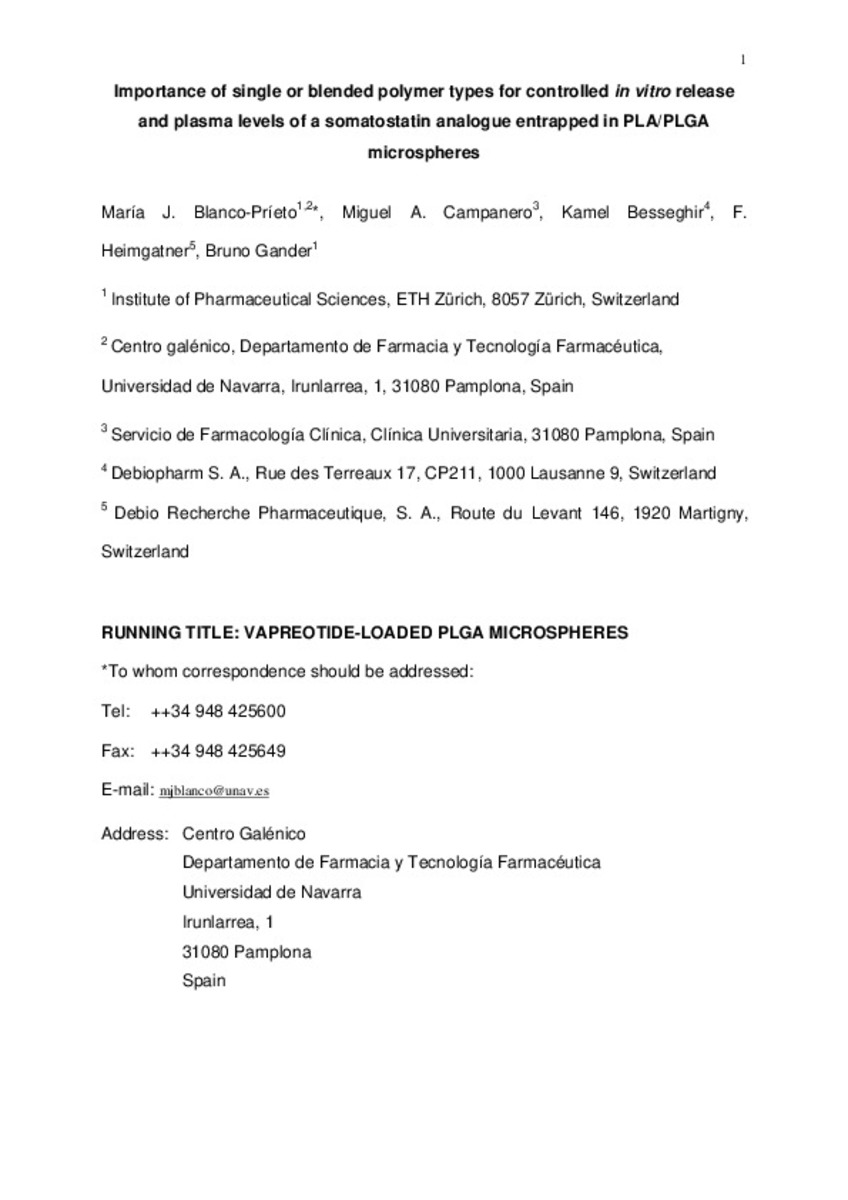Full metadata record
| DC Field | Value | Language |
|---|---|---|
| dc.creator | Blanco-Prieto, M.J. (María José) | - |
| dc.creator | Campanero, M.A. (Miguel Angel) | - |
| dc.creator | Besseghir, K. (Kamel) | - |
| dc.creator | Heimgartner, F. (Fréderic) | - |
| dc.creator | Gander, B. (Bruno) | - |
| dc.date.accessioned | 2012-06-01T08:58:55Z | - |
| dc.date.available | 2012-06-01T08:58:55Z | - |
| dc.date.issued | 2004-05 | - |
| dc.identifier.citation | Blanco-Prieto MJ, Campanero MA, Besseghir K, Heimgatner F, Gander B. Importance of single or blended polymer types for controlled in vitro release and plasma levels of a somatostatin analogue entrapped in PLA/PLGA microspheres. J Control Release 2004 May 18;96(3):437-448. | es_ES |
| dc.identifier.issn | 0168-3659 | - |
| dc.identifier.uri | https://hdl.handle.net/10171/22386 | - |
| dc.description.abstract | The aim of the work was to develop biodegradable microspheres for controlled delivery of the somatostatin analogue vapreotide and maintenance of sustained plasma levels over 2–4 weeks after a single injection in rats. Vapreotide was microencapsulated into end-group capped and uncapped low molecular weight poly(lactide) (PLA) and poly(lactide-co-glycolide) (PLGA) by spray-drying and coacervation. Microspheres were prepared from single and blended (1:1) polymer types. The microparticles were characterized for peptide loading, in vitro release and pharmocokinetics in rats. Spray-drying and coacervation produced microspheres in the size range of 1–15 and 10–70 μm, respectively, and with encapsulation efficiencies varying between 46% and 87%. In vitro release of vapreotide followed a regular pattern and lasted more than 4 weeks, time at which 40–80% of the total dose were released. Microspheres made of 14-kDa end-group uncapped PLGA50:50 or 1:1 blends of this polymer with 35 kDa end-group uncapped PLGA50:50 gave the best release profiles and yielded the most sustained plasma levels above a pre-defined 1 ng/ml over approximately 14 days. In vitro/in vivo correlation analyses showed for several microsphere formulations a linear correlation between the mean residence time in vivo and the mean dissolution time (r=0.958) and also between the amount released between 6 h and 14 days and the AUC6h–14d (r=0.932). For several other parameters or time periods, no in vitro/in vivo correlation was found. This study demonstrates that controlled release of the vapreotide is possible in vivo for a duration of a least 2 weeks when administered i.m. to rats. These results constitute a step forward towards a twice-a-month or once-a-month microsphere-formulation for the treatment of acromegaly and neuroendocrine tumors. | es_ES |
| dc.language.iso | eng | es_ES |
| dc.publisher | Elsevier | es_ES |
| dc.rights | info:eu-repo/semantics/openAccess | es_ES |
| dc.subject | Vapreotide | es_ES |
| dc.subject | PLGA microspheres | es_ES |
| dc.subject | Polymer blend | es_ES |
| dc.subject | Controlled release | es_ES |
| dc.subject | IVIV correlation | es_ES |
| dc.title | Importance of single or blended polymer types for controlled in vitro release and plasma levels of a somatostatin analogue entrapped in PLA/PLGA microspheres. | es_ES |
| dc.type | info:eu-repo/semantics/article | es_ES |
| dc.type.driver | info:eu-repo/semantics/article | es_ES |
| dc.identifier.doi | http://dx.doi.org/10.1016/j.jconrel.2004.02.015 | es_ES |
Files in This Item:
Statistics and impact
Items in Dadun are protected by copyright, with all rights reserved, unless otherwise indicated.






